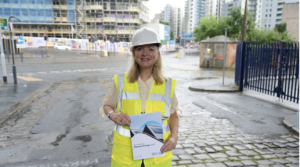Q & A with Dawn Austwick: Building an open source, bottom-up, funding model
 Dawn Austwick joined the Big Lottery Fund as its chief executive in October last year. She talks to New Start about the future of the voluntary sector, big data and inverting the funding model.
Dawn Austwick joined the Big Lottery Fund as its chief executive in October last year. She talks to New Start about the future of the voluntary sector, big data and inverting the funding model.
You’re keen on a more open source funding model. Can you explain? At Esmee Fairbairn [where she was chief executive until moving to the Big Lottery Fund] we developed a blended model of funding which was very responsive and demand led. One of the things that interests me at the Big Lottery Fund is how we make the most of the intelligence and the data we receive and use that to decide the things we say yes to and also the things we say no to and how we can feed all that into our strategic thinking. If you’re small like Esmee you do that by osmosis but if you are a big organisation you need processes and systems to do it. With technology we have a real opportunity to do more. So we want to be much more open source. We want to make our data much more open and available so it’s not just us interrogating our data and trends but about sharing that with other people and enabling them to interrogate our material too.
We’ve made available all of our data since 2004 but at quite a crude level. To push it forward you’d want to work out which of the core elements of that architecture you need to make it consistent so the next stage is to start thinking about that. Once you put things out there the genie is out of the bottle and we can do lots of our own analysis work and others can have fun too.
How do you hope that big data will change the grantmaking and voluntary sectors?
It will enable us to see where we aren’t funding and to get a sense of ‘cold spots’ and it will also enable beneficiary communities to see if there’s a particular issue in their area. At the moment it’s all a bit hidden – not deliberately – but technology opens it up.
If someone, for example, wanted to find out the level of environmental funding in east Midlands they couldn’t easily do that now. It would be good to reach a point where there is a critical mass of data so that people in the east Midlands can work it out for themselves. That would make us a much more accessible and transparent sector and there’s an opportunity for the Big Lottery Fund to play a role in making that happen as we have the scale, scope and reach that a lot of funders don’t have.
And then there’s the idea of getting the voluntary sector to be more proactive in its management of data. A classic example is, if I’ve got seven funders I need to produce seven reports for each funder, all in different formats. How about creating a world in which that charity puts 90% of their report out there and the funder draws it out itself and then if they want the extra 10% they could ask for it?
If we’ve got such common data at the level of impact and effectiveness – and it could be narrative as well as metric – that enables a charity in Cornwall for example to search and discover there are three other charities in the UK doing similar stuff and maybe they should talk to each other.
And this would enable charities to see what others are doing and learn and replicate?
Yes, though it’s more of a ‘compare and contrast and learn’ than ‘scale and replicate’. I went to Nottingham recently to see Double Impact Services, a charity that deals with drug users. It had set up a high street non-alcoholic bar run by ex–users. They were fantastic and they’d come across an organisation in Liverpool who did something very similar and had learned from it. That is absolutely what you want and what you have there is adaptation. We’ve had this notion for a while that all you have to do is find a great idea and scale it up so that you have twenty in different places. But the reason why the one works in Liverpool is that it is run by a social entrepreneur who is passionate about this project in their place. They work because they are customised and grow out of their location rather than being transported in. So, it would be an amazing opportunity for Big Lottery to enable that process of adaptation. There might end up being ten projects that look alike but they might all be independent and they may be more efficient by being small and beautiful. The idea of economies of scale doesn’t necessarily work when you’re working in such localised environments.
You’ve recently launched Power to Change, a community enterprise fund. What’s new about it?
It’s about trying to build a more sustainable model. An interesting challenge for all of us is how to create a more sustainable voluntary and community sector. It’s partly about money and partly about capability and Power to Change is a slice of that. It’s looking specifically at community assets and recognising that there are economic models around assets that can build in a greater degree of sustainability. With some help and facilitation and skills development the hope is we’ll create a whole series of community organisations. At Esmee Fairbairn we were partners in a great scheme around community shops with the Plunkett Foundation. The premise was that community shops are shutting down but often they are the focus of community. Esmee provided one third of the funding in grant finance and the Co-operative and Community Finance provided a third in loans and the community had to raise a third and then Plunkett ran the project. Wrapped around that was financial and business advice of Co-operative and Community Finance. The scheme had a 96% sustainability rate, which is very high for retail. It’s that sort of model. It could be a library, woodland, a sports centre, but you’re putting the power and control in the hands of community and helping them build a model that gives them a degree of control. They are forging their own destiny.
The Fair Share initiative recently came to an end and was evaluated. What learning came out of that?
Fair Share started from our concerns about cold spots and those areas with a great deal of disadvantage. We set up a trust with Community Foundation to deliver funding, but for the choices and delivery of that money to be made by local people. The Community Foundation was a good way of getting in at a grassroots level and that was hugely successful. It was instrumental in how to do more locally-led things and led into Big Local and probably also influenced Power to Change. There is a theme in there about recognizing the importance of social capital and change and in seeing situations and people and places as assets and opportunities rather than negatives and deficits. It’s about recognising that if you can get the money in at a grassroots level and you are equipping people through funding and enabling people to make choices, then that’s the best place for that kind of decision-making. Your money is the catalyst for them deciding what to do.
How have these community-based funding schemes developed over time?
The basic model hasn’t changed but it might be on a bigger scale now and have more support. You always underestimate how long things take so the time scales have been extended. Some communities take longer to get to year one. We’ve recognised that this is long term community development and the level of wraparound support and development needed.
I’m really interested in the notion of inversion, moving from working at the funder’s pace to working at the community’s pace. The funder currently has all the control, but inverting that really gets results. You’ve got to be a tough enabler and that’s a slightly different way of thinking of things. There’s a real danger of funders setting agendas too much. The current model has communities at the bottom and big funders at the top. Wouldn’t it be great to flip that around and have the funders at the bottom doing the listening and responding? But the problem with being a funder is that people don’t often tell you the truth but what you want to hear. Practitioners have solutions to problems, not funders, and funders should listen to them and hear and respond to what practitioners say.
What is the future of the voluntary sector in your opinion?
I think the changes the voluntary sector face are manifold. The tectonic plates are shifting: you have a different economy; a different demographic; all sorts of technology changes; the relationships in the post-war settlement of public, private, civil society being renegotiated; the ‘who does what?’ and ‘who pays for what?’ is all changing. Public attitudes and the whole notion of what is charity is changing. There’s a whole load of things to ponder and think about. Our role at the Big Lottery Fund is to be as thoughtful as we can about using our money to best support those who can effect change around individuals and communities in that very dynamic market. We need to be good stewards of the money that we are custodians of in terms of the choices we make in order to support our beneficiary communities through times of quite significant change and hardship. If we could achieve that I’d say, ‘Job well done!

















